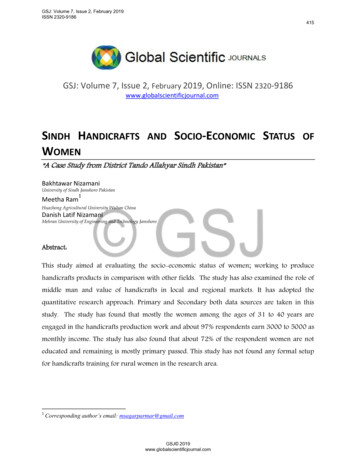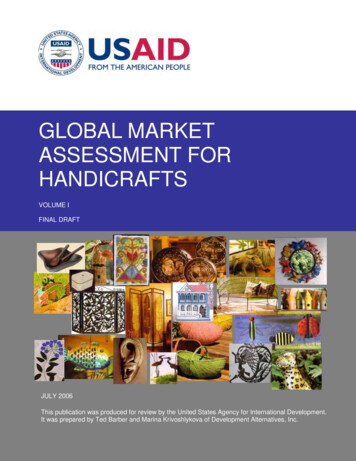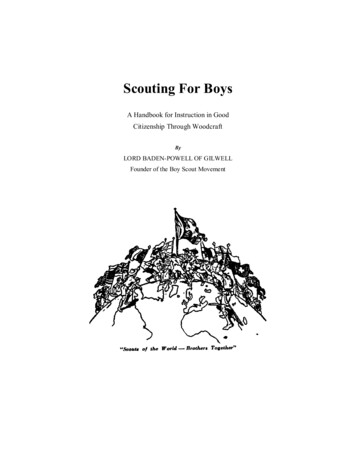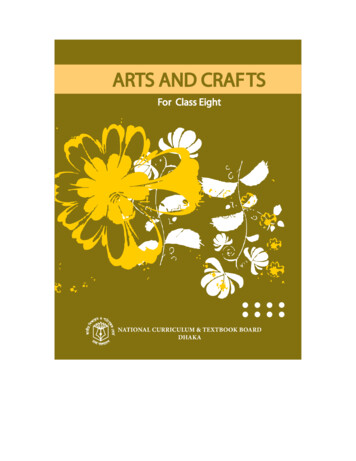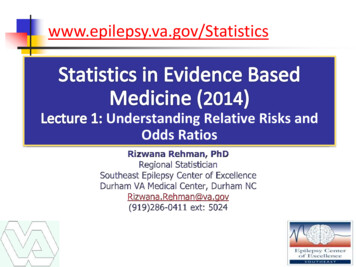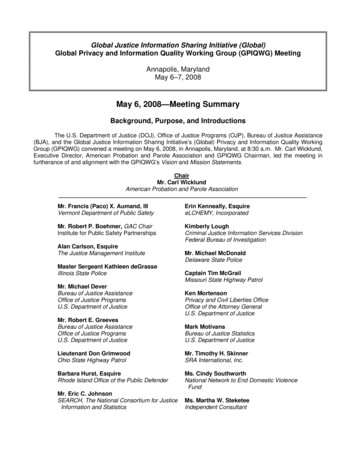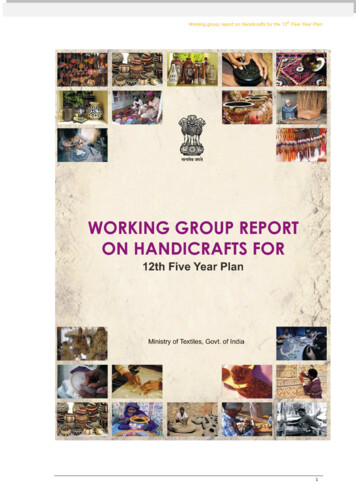
Transcription
Working group report on Handicrafts for the 12th Five Year Plan1
Working group report on Handicrafts for the 12th Five Year PlanPrefaceHandicrafts of India represent our cultural tradition in true sense, as Indian way of life isreplete with products made with the help of simple, indigenous tools by crafts people whobelong within a strong fabric of tradition, aesthetic and artistry. The range of IndianHandicraft is as diverse as the culture diversity of the country. They embody our heritage ofcreativity, aesthetics and craftsmanship. At a more substantial level the Handicraft traditionhas sustained generation of people in our country. As a highly decentralized activity theHandicraft industry is a shining example of using local resources and local initiatives.The 11th Plan faced the great challenges due to the changing economic climate and theglobal recession. The effects were seen in the first three years of the plan period. However,due to the various policy initiatives of the government, the last two years of the plan periodhave seen improvement and increasing growth rates. The operational schemes of the 11thPlan showed merit, registering a growth of approximately 20% in exports. Many artisanswho had left the sector, started to get involved in the industry. Despite the difficulties facedby the sector in the 11th Plan, it has shown resilience and is growing stronger. At present,it is estimated that we have a work force of almost 70 lakh and export worth Rs. 10,000 Cr.With the above background, the Working Group started its deliberation for preparation of astrategy for the 12th Plan Period, with the aim to create a globally competitive HandicraftsSector providing sustainable livelihood opportunities to the artisans and thereby resulting ininclusive socio-economic development at the grass root level.All the members of theWorking group during the deliberations had shown keen interest and provided useful inputsfor the betterment of the sector. This is a perfect example of Government and Civil societyworking together in order to create a model for development which will address the need ofall concerned.Through this report we have tried to touch upon all relevant issues which will be affectingthe sector in future. For this purpose different sub groups were constituted so that eachtopic can be deliberated comprehensively.Further, the inputs given by differentstakeholders during formal/informal consultation have also found to be very useful for thepurpose.The report not only indicates the problems but also has provided probablesolutions for the same.1
Working group report on Handicrafts for the 12th Five Year PlanI once again thanks all the Working Group and Sub group members along with all otherpersons involved in this report preparation for their contribution because of which this reporthas become the possibility in such a short time.Rita MenonSecretary [Textiles]/Chairperson Working Group2
Working group report on Handicrafts for the 12th Five Year PlanAcknowledgementThe task of preparation report of the Working Group on Handicrafts Sector for 12th Planwas a very challenging. It required constant guidance & continuous inputs to bring thereport in this shape within the given time.This task could not have been accomplished without the active support & hands onguidance of Secretary [Textiles] who as the Chairperson of the Committee has given priorityto this report over any other item of work. She has provided encouragement to all of us atevery stage of report preparation. Her involvement in this work has driven us all to performthis task on schedule.This report could not have been completed without the splendid support and cooperation ofthe members of the Working Group and the Subgroups. The members of these groupsspared their valuable time to ensure presence in the meetings and provide inputs forpreparing the report.document.TheTheir comments and suggestions form an integral part of tpersons/stakeholders who were though not a member of these groups but still had providedtheir suggestions for the betterment of the sector.Among the members and invitees, special help was extended in preparing this document byMrs. Gulshan Nanda, Co-chairperson of the Working Group, Mrs. Alka Arora, Addl.Development Commissioner for Handicrafts, Shri Rohit Bhardwaj, Director[Handicrafts],Shri Rakesh Kumar, Executive Director, Export Promotion Council for Handicrafts, Shri R.K.Srivastava, Executive Director, National Centre for Design & Product Development andofficers & staff of Office of the Development Commissioner [Handicrafts].I also extend my special thanks to different organization involved for completing this tasksuccessfully and in time bound manner.S.S. GuptaDevelopment Commissioner [Handicrafts]/Member Convener Working Group3
Working group report on Handicrafts for the 12th Five Year PlanBackground and MethodologyAs part of the process for the preparation of the 12th plan report, a Working Group (WG) onthe Handicrafts sector was constituted to analyze the sector, formulate goals and createrecommendations.The WG on Handicrafts held its first meeting on 14.06.2011 chaired by Secretary (Textiles).It finalized the methodology and time line completion of the plan as well as constituted thesubgroups and drafted ToRs for these sub-groups. Five subgroups were constituted, andeach subgroup met three times between the months of June, July and August 2011. Thedetails of the subgroups and meetings held is summarized in the following tablestndrdName of the subgroupDate of 1meetingDate of 2meetingDate of 3meetingI - Brand Building, Marketing, Craft Promotion,Advocacy and Entrepreneurship21.06.201111.07.201128.07.2011II - Cluster, Infrastructure and Technology27.06.201112.07.201129.07.2011III - Artisan Welfare27.06.201112.07.201129.07.2011IV - Research, Education, Training, Design andCompliance Issues27.06.201112.07.201128.07.2011V- Inputs, Credit, Raw Material28.06.201113.07.201129.07.2011The key agenda of these meetings was to have elaborate discussions on the identifiedtopics as per the ToR for each subgroup and finalize a set of recommendations for the 12thFYP. The recommendations were documented and reports were prepared for each subgroup.The recommendations of the subgroup were presented to the working group in the secondmeeting of the group held on 17th August 2011. The working group made suggestions to forimprovements in the 12th plan proposals and accordingly this consolidated report has beenprepared.The methodology adapted for the preparation of the Draft Working Group report for 12thPlan Period may be summarized in the following points:Constitution of Working GroupFirst meeting of the Working GroupConstitution of SubgroupsMeetings with the Subgroups4
Working group report on Handicrafts for the 12th Five Year PlanCirculation of feedback form to the members and regional offices of the DC(H)Meeting with regional directors, field formations and implementing agenciesReview and analysis of all suggestions receivedPreparation of Subgroup ReportsPresentation of the report to the subgroup membersIncorporation of the feedback receivedPreparation of the final subgroup reportsSecond meeting of the Working GroupPreparation of the Draft Working Group reportCirculation of the draft report to all working group members for comments andsuggestionsRevisions to the draft report incorporating the suggestionsPreparation of final Working group report5
Working group report on Handicrafts for the 12th Five Year PlanTable of ContentsPreface . 1Acknowledgement . 3Background and Methodology . 4List of tables . 10List of Figures . 11List of Case Studies. 11Abbreviations . 12Executive Summary. 141Handicrafts sector overview. 281.1 Historic Development of approach to the handicraft’s sector . 291.2 Constraints in the Handicrafts sector. 301.3 SWOT Analysis . 332Review of Handicraft sector’s overall performance during the 11th plan period . 352.1 Growth in the handicraft sector in the 11th plan period . 362.1.1 Growth in exports . 362.1.2 Growth in domestic market . 382.1.3 Growth in production . 382.1.4 Growth in employment . 393Performance review 11th plan schemes . 413.1 Babasaheb Ambedker Hastshilp Vikas Yojna (AHVY) . 413.1.1 Scheme details . 443.1.2 Physical and financial performance of the AHVY scheme . 463.1.3 Major achievements during the 11th plan period . 493.1.4 Key challenges . 503.2 Design and Technology up-gradation scheme (DTUS) . 573.2.1 Scheme details . 573.2.2 Physical and financial achievements . 583.2.3 Key challenges . 603.3 Marketing Support and Services Scheme (MSS) . 623.3.1 Scheme details . 623.3.2 Physical and financial performance of the MSS scheme . 633.3.3 Key challenges . 656
Working group report on Handicrafts for the 12th Five Year Plan3.4 Human Resource Development Scheme (HRD) . 673.4.1 Scheme details . 673.4.2 Physical and financial achievements of HRD scheme . 683.4.3 Key challenges . 693.5 Comprehensive Artisan Welfare Scheme . 713.5.1 Rajiv Gandhi Shilpi Swasthya Bima Yojana (RGSSBY) . 713.5.2 Janashree Bima Yojana for Handicrafts Artisans . 733.5.3 Key issues/challenges . 763.6 Research and Development Scheme (R&D) . 813.6.1 Scheme details . 813.6.2 Physical and financial achievements . 823.6.3 Key challenges . 864Key cross cutting issues . 884.1 Gender concerns . 884.2 Credit . 904.3 Compliance . 944.4 Languishing crafts . 974.5 Geographical indications . 984.6 Advocacy and policy support. 1004.7 Marketing of handmade carpet. 1004.8 Entrepreneurship development . 1014.9 Brand promotion . 1024.10 Raw material . 1024.11 Infrastructure. 1044.12 Technology . 1055Projections for 12th plan period . 1095.1 Growth in exports . 1095.2 Growth in production and domestic consumption . 1115.3 Growth in employment . 1155.4 Credit requirement for 12th plan period . 1165.5 Estimation of Raw Material requirement . 1186Vision and strategy for the 12th plan period . 1217Proposed modifications to the existing schemes . 1257.1 Babasaheb Ambedker Hastshilp Vikas Yojna (AHVY) . 1267.1.1 Recommendations for restructuring of existing AHVY scheme. 1267.1.2 Implementation model for cluster development . 1277
Working group report on Handicrafts for the 12th Five Year Plan7.1.3 Proposed modifications in the existing scheme components. 1297.1.4 Implementation Framework . 1347.1.5 Targets and benefits for the AHVY scheme . 1367.2 Design and Technology up-gradation scheme (DTUS) . 1377.2.1 Recommendations . 1377.2.2 Proposed modifications in the existing scheme components. 1397.2.3 Proposed new components. 1407.2.4 Targets and benefits for the Design and Technology up-gradation scheme . 1437.3 Marketing Supply and Services Scheme (MSS) . 1457.3.1 Recommendations . 1457.3.2 Proposed modifications in the existing scheme components. 1477.3.3 New components proposed in the MSS scheme . 1517.3.4 Targets and benefits for the MSS scheme . 1587.4 Human Resource Development Scheme (HRD) . 1617.4.1 Recommendations . 1617.4.2 Proposed modifications in the existing scheme components. 1627.4.3 Proposed new components. 1647.4.4 Targets and benefits for the HRD scheme . 1657.5 Comprehensive Artisan Welfare Scheme . 1667.5.1 Recommendations . 1667.5.2 Proposed modifications in the existing scheme components. 1697.5.3 Proposed new component . 1707.5.4 Beneficiaries from the Comprehensive Artisan Welfare scheme . 1767.6 Research and Development Scheme (R&D) . 1777.6.1 Recommendations . 1777.6.2 Proposed modifications in the existing scheme components. 1787.6.3 Proposed new component . 1797.6.4 Targets and benefits for the R&D scheme. 1798Addressing the special focus areas in the 12th plan . 1828.1 Women, Minority and SC/ST communities . 1828.2 Marketing of handmade carpets . 1838.3 Brand Building and Geographic Indicators . 1878.4 Geographic Indicators . 1888.5 Languishing crafts . 1888.6 Entrepreneurship development . 1898.7 Advocacy and policy support. 1898
Working group report on Handicrafts for the 12th Five Year Plan8.8 Housing and Workshed . 1908.9 Monitoring and Evaluation (M&E) . 1919Proposed new schemes for the 12th plan period . 1939.1 Infrastructure and Technology Development Scheme . 1939.1.1 Need and Justification . 1939.1.2 Objectives of the scheme . 1949.1.3 Proposed scheme components . 1959.1.4 Strategy for ‘Technology’ induction . 1999.1.5 Detailed concepts for the new scheme components . 2009.1.6 Targets for the Infrastructure scheme . 2249.2 Special scheme for the North Eastern Region (NER) . 2259.2.1 Special needs of the Handicrafts sector in NER . 2259.2.2 Objective of the special package for NER . 2269.2.3 Major components . 2269.2.4 Eligibility . 2279.2.5 Targets for the NER scheme . 22710 Financial outlay . 23011 Annexure . 23811.1 Annex 1: Component-wise details of eligibility and financial allocations for existingschemes of DC(H) . 23811.2 Order of constitution of the Working Group . 25311.3 Minutes of meetings of the Working Group . 25711.4 Orders for creation of subgroups and Minutes of meetings (MoM) for subgroupmeetings . 26911.4.1 Subgroup I: Brand Building, Marketing, Craft Promotion, Advocacy andEntrepreneurship . 26911.4.2 Subgroup II: Cluster, Infrastructure and Technology . 29711.4.3 Subgroup III: Artisan Welfare . 31611.4.4 Subgroup IV: Research, Education, Training, Design and Compliance Issues33611.4.5 Subgroup V: Inputs, Credit, Raw Material . 35511.4.6 Corrigendum . 3729
Working group report on Handicrafts for the 12th Five Year PlanList of tablesTable 1-1: SWOT analysis of handicraft sector . 33Table 2-1: Scheme wise details of fund utilization. 36Table 2-2: Growth of exports in the handicrafts and carpet industry . 38Table 2-3: Growth in domestic market . 38Table 2-4: Growth in production. 38Table 3-1: List of Handicrafts clusters in India . 43Table 3-2: Production centres in India . 44Table 3-3: Scheme components of AHVY. 44Table 3-4: Cluster and artisan coverage under AHVY scheme (totals) . 46Table 3-5: Cluster and artisan coverage under AHVY scheme (details). 46Table 3-6: State-wise list of projects sanctioned and artisan coverage . 48Table 3-7: Performance of infrastructure component under AHVY scheme . 49Table 3-8: Financial performance of the AHVY scheme. 49Table 3-9: Physical achievements of the DTUS in the 11th plan period . 60Table 3-10: Financial outlay of DTUS in 11th plan period . 60Table 3-11: The components of the MSS scheme . 62Table 3-12: Physical achievements in the 11th plan period . 63Table 3-13: Financial achievements in the 11th plan period . 65Table 3-14: Component wise expenditure in 11th plan period . 65Table 3-15: Physical achievements of the HRD scheme in the 11th plan period . 68Table 3-16: Financial achievements of HRD scheme in the 11th plan period. 69Table 3-17: Artisans covered by the RGSSBY scheme . 72Table 3-18: Claims status under the RGSSBY scheme . 73Table 3-19: Year wise details on the number of health camps organized under the RGSSBY. 73Table 3-20: Artisans covered by the Bima Yojna . 75Table 3-21: Year wise details on the number of insurance claims settled under the BimaYojana scheme . 75Table 3-22: Year wise break up of number of scholarships and amount paid under theShiksha Sahyog Yojana. 75Table 3-23: Year wise breakup of the grant and expenditure . 76Table 3-24: Key studies commissioned during the 11th plan period . 83Table 3-25: Physical achievements of the R&D scheme in the 11th plan period . 8410
Working group report on Handicrafts for the 12th Five Year PlanTable 3-26: Financial achievements of the R&D scheme in the 11th plan period . 84Table 4-1: Details of purposes of credit . 92Table 4-2: Number of raw material sanctioned under AHVY . 103Table 4-3: Technology mapping of major handicraft clusters in India . 106Table 5-1: Estimated credit requirement by category of craft . 116Table 5-2: Assessment of credit requirement of the Handicrafts sector (Rs. Crores) . 117Table 5-3: Raw materials used in various craft categories . 118Table 5-4: Estimated annual raw material requirement . 119Table 7-1: Proposed modifications in the MSS scheme . 147Table 9-1: Analysis of the total investment in infrastructure under the AHVY . 194Table 9-2: Component wise distribution of expenditure in AHVY . 194List of FiguresFigure 1-1: Growth of exports in the handicrafts sector . 30Figure 2-1: Export of handicraft and carpets in the 11th Five Year Plan . 37Figure 2-2: Growth% of handicrafts and carpets in 11th Five Year Plan . 37List of Case StudiesCASE STUDY 1: Occupational Health and Safety issues . 78CASE STUDY 2: ‘ABHAY HASTAM’ Scheme of Andhra Pradesh . 79CASE STUDY 3: ‘SWAVALAMBAN’ Scheme . 80CASE STUDY 4: Environmental compliance, occupational health and safety issues. 94CASE STUDY 5: Geographic Indication . 99CASE STUDY 6: National Handlooms Expo . 153CASE STUDY 7: Department of Craft, Tokyo National University of Fine Arts and Music. 203CASE STUDY 8: Glass School, Novi Bur . 218CASE STUDY 9: TESDA Women’s Centre – an internationally recognised centre ofexcellence . 22011
Working group report on Handicrafts for the 12th Five Year PlanAbbreviationsB2BBusiness to BusinessAHVYBabasaheb Ambedkar Hastshilp Vikas YojanaCEPCCarpet Export Promotion CouncilCOHANDSCouncil of Handicrafts Development CorporationsCSRCorporate Social ResponsibilityDADearness AllowanceDC(H)Development Commissioner (Handicrafts)DMAPDesign Mentorship and Apprentice ProgrammeDTUSDesign and Technology up-gradation schemeEDPEntrepreneurship Development ProgrammeEPCHExport Promotion Council for HandicraftsGIGeographical IndicationHRDHuman Resource DevelopmentICCRIndian Council of Cultural RelationsIICTIndian Institute of Carpet TechnologyIIFTIndian Institute of Foreign TradeJBYJanashree Bima YojanaMHSCMetal Handicraft Service CentreMoTMinistry of TextilesMSSMarketing Support and Services SchemeNCDPDNational Centre for Design an
Working group report on Handicrafts for the 12 th Five Year Plan 4 Background and Methodology As part of the process for the preparation of the 12 th plan report, a Working Group (WG) on the Handicrafts sector was constituted to analyze the sector, formulate goals and create
